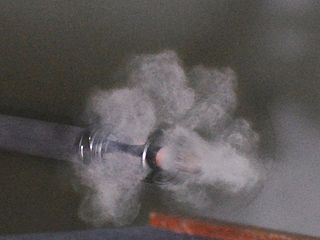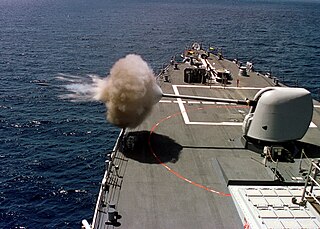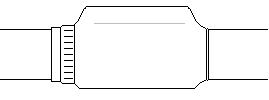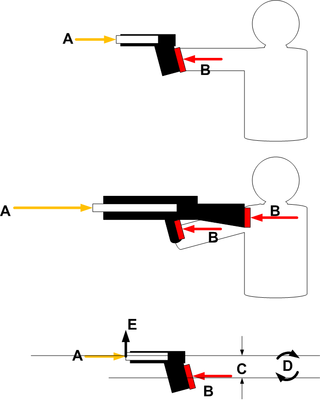
A muzzle brake or recoil compensator is a device connected to, or a feature integral to the construction of, the muzzle or barrel of a firearm or cannon that is intended to redirect a portion of propellant gases to counter recoil and unwanted muzzle rise. Barrels with an integral muzzle brake are often said to be ported.

Recoil is the rearward thrust generated when a gun is being discharged. In technical terms, the recoil is a result of conservation of momentum, as according to Newton's third law the force required to accelerate something will evoke an equal but opposite reactional force, which means the forward momentum gained by the projectile and exhaust gases (ejectae) will be mathematically balanced out by an equal and opposite momentum exerted back upon the gun.
From the viewpoint of physics, a firearm, as for most weapons, is a system for delivering maximum destructive energy to the target with minimum delivery of energy on the shooter. The momentum delivered to the target, however, cannot be any more than that on the shooter. This is due to conservation of momentum, which dictates that the momentum imparted to the bullet is equal and opposite to that imparted to the gun-shooter system.
Muzzle velocity is the speed of a projectile with respect to the muzzle at the moment it leaves the end of a gun's barrel. Firearm muzzle velocities range from approximately 120 m/s (390 ft/s) to 370 m/s (1,200 ft/s) in black powder muskets, to more than 1,200 m/s (3,900 ft/s) in modern rifles with high-velocity cartridges such as the .220 Swift and .204 Ruger, all the way to 1,700 m/s (5,600 ft/s) for tank guns firing kinetic energy penetrator ammunition. To simulate orbital debris impacts on spacecraft, NASA launches projectiles through light-gas guns at speeds up to 8,500 m/s (28,000 ft/s). FPS and MPH are the most common American measurements for bullets. Several factors, including the type of firearm, the cartridge, and the barrel length, determine the bullet's muzzle velocity.

A flash suppressor, also known as a flash guard, flash eliminator, flash hider, or flash cone, is a muzzle device attached to the muzzle of a rifle that reduces its visible signature while firing by cooling or dispersing the burning gases that exit the muzzle, a phenomenon typical of carbine-length weapons. Its primary intent is to reduce the chances that the shooter will be blinded in low-light shooting conditions. Contrary to popular belief, it is only a minor secondary benefit if a flash suppressor reduces the intensity of the flash visible to the enemy.

A gun barrel is a crucial part of gun-type weapons such as small firearms, artillery pieces, and air guns. It is the straight shooting tube, usually made of rigid high-strength metal, through which a contained rapid expansion of high-pressure gas(es) is used to propel a projectile out of the front end (muzzle) at a high velocity. The hollow interior of the barrel is called the bore, and the diameter of the bore is called its caliber, usually measured in inches or millimetres.

A gunshot is a single discharge of a gun, typically a man-portable firearm, producing a visible flash, a powerful and loud shockwave and often chemical gunshot residue. The term can also refer to a ballistic wound caused by such a discharge.
Internal ballistics, a subfield of ballistics, is the study of the propulsion of a projectile.

A blank is a firearm cartridge that, when fired, does not shoot a projectile like a bullet or pellet, but generates a muzzle flash and an explosive sound like a normal gunshot would. Firearms may need to be modified to allow a blank to cycle the action, and the shooter experiences less recoil with a blank than with a live round. Blanks are often used in prop guns for shooting simulations that have no need for ballistic results, but still demand light and sound effects, such as in historical reenactments, special effects for theatre, movie and television productions, combat training, for signaling, and cowboy mounted shooting. Specialised blank cartridges are also used for their propellant force in fields as varied as construction, shooting sports, and fishing and general recreation.

Transitional ballistics, also known as intermediate ballistics, is the study of a projectile's behavior from the time it leaves the muzzle until the pressure behind the projectile is equalized, so it lies between internal ballistics and external ballistics.

A bore evacuator or fume extractor is a device which removes lingering gases and airborne residues from the barrel of an armored fighting vehicle's gun after firing, particularly in tanks and self-propelled guns. By creating a pressure differential in the barrel after the shell leaves, the bore evacuator causes most of the propellant gases and combustion residues to exit via the muzzle. Thus, when the breech opens for reloading, those gases and residues do not escape into the crew compartment and pose a hazard to the gun crew.

A contact shot is a gunshot wound incurred while the muzzle of the firearm is in direct contact with the body at the moment of discharge. Contact shots are often the result of close-range gunfights, suicide, or execution.
A muzzle booster or recoil booster is a device fixed to the muzzle of a firearm, intended to harness the energy of the escaping propellant to augment the force of recoil on portions of the firearm. In spite of its name, a muzzle booster does not increase muzzle force or velocity but instead is usually used to improve the reliability and/or rate of fire of a recoil operated firearm. It was invented by Hiram Maxim in 1894.

Muzzle flash is the light — both visible and infrared — created by a muzzle blast, which is caused by the sudden release and expansion of high-temperature, high-pressure gases from the muzzle of a firearm during shooting. Both the blast and flash are products of the exothermic combustion of the propellant (gunpowder), and any remaining unburned powders reacting with ambient air. The size and shape of the muzzle flash is dependent on the combustion energy of propellant being used, the amount of combustible ejecta remaining, and any devices attached to the muzzle.
The following are terms related to firearms and ammunition topics.

Power Factor (PF) in practical shooting competitions refers to a ranking system used to reward cartridges with more recoil. Power factor is a measure of the momentum of the bullet, which to some degree reflects the recoil impulse from the firearm onto the shooter.

Muzzle rise, muzzle flip or muzzle climb refers to the tendency of a firearm's or airgun's muzzle to rise up after firing. It more specifically refers to the seemingly unpredictable "jump" of the firearm's muzzle, caused by combined recoil from multiple shots being fired in quick succession. It has an adverse effect on maintaining accuracy with using automatic weapons or rapid-firing semi-automatic firearms, as a moving muzzle can throw off the shooter's aim, causing subsequent shots to miss the intended target.

A muzzle shroud, linear compensator, blast shield, forward blast diverter or concussion reduction device (CRD) is a sleeve that attaches to and extends beyond the muzzle of a firearm in order to redirect some of the noise and concussion, or shock wave, from the muzzle blast forward and away from the shooter, and other bystanders, behind and to the sides.
Recoil operation is an operating mechanism used to implement locked-breech autoloading firearms. Recoil operated firearms use the energy of recoil to cycle the action, as opposed to gas operation or blowback operation using the pressure of the propellant gas.

A silencer, also known as a sound suppressor, suppressor, or sound moderator, is a muzzle device that suppresses the blast created when a gun is discharged, thereby reducing the acoustic intensity of the muzzle report and jump, by modulating the speed and pressure of the propellant gas released from the muzzle. Like other muzzle devices, a silencer can be a detachable accessory mounted to the muzzle, or an integral part of the barrel.




















